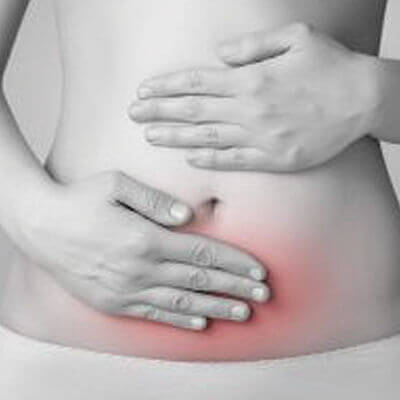What is Pelvic Prolapse?

Pelvic organ prolapse (POP) refers to the sagging or drooping of any pelvic organs due to damage, trauma, childbirth or injury.
The pelvic floor consists of a group of cradle-shaped muscles that hold pelvic organs in place. The pelvic organs include the uterus, bladder, cervix, vagina, rectum and intestines. Like any other part of the body, these muscles, with their surrounding tissues (fascia), can develop problems.
If you fill a small plastic bag with grocery items, say for instance, a box of cereal, a few cans of vegetables, some jars and a package of rice —the bag should hold the items with no problem. But if you hang that full bag on a wall hook and leave it suspended, you’ll start to notice the items in it begin to bulge against the membrane of the bag as it takes on the shape of its contents.
After a while, depending on how heavy the items are, the corner of the cereal box or rim of a can may start to bulge and even poke through as the bag stretches, weakens and eventually tears from the weight of the items in it. The groceries may even begin to protrude and dangle outside of the bag as the tears get larger.
Pelvic prolapse happens much the same way. As the muscles and tissues holding the pelvic organs weaken, degrade or tear, the pelvic organs slip or drop through, sometimes forming a small hanging internal bulge. At other times, depending on the damage, they may actually dangle externally from the vagina or anus, causing problems and inhibiting their function. This is called prolapse.
Who is at Risk for Pelvic Organ Prolapse?
One in three women suffer from POP. Any activity that puts undue pressure on the abdomen can cause pelvic floor disorders. Typically, labor and childbirth are the leading causes of prolapse, especially when a woman has had several children, a long, difficult labor, or has given birth to a larger child.
Pelvic organ prolapse becomes more common with age, usually around menopause when tissues damaged during a woman’s childbearing years begin to lose strength. Other causes are:
- Obesity: Excess weight places increased pressure on the abdomen.
- Pelvic organ cancers: Tumors can also put additional pressure on the abdomen.
- Constipation: The bowel puts increased pressure on the vaginal wall when constipation is a chronic problem.
- Uterus removal (hysterectomy): During surgery, there is always a possibility of inflicting damage on pelvic organ support, resulting in dislocation of any organ within the pelvis.
- Smoking and respiratory problems: Excessive coughing, especially if chronic, can put extra strain on the abdomen.
- Genetics: Pelvic connective tissue weakness may be hereditary. Often, if immediate female family members have suffered from prolapse, there is a greater possibility that you will too.
- Heavy lifting: Excess abdominal pressure from heavy lifting may cause POP.
- Diseases of the nervous system: There is a greater risk of developing pelvic organ prolapse for women who suffer from multiple sclerosis, spinal cord injury or muscular dystrophy.
What are the Symptoms of Pelvic Organ Prolapse?
It is entirely possible not to have any symptoms at all. Sometimes pelvic organ prolapse is only discovered during a routine gynecological examination. Minor symptoms are a feeling of annoying pressure of the uterus or other pelvic organs against the vaginal wall, minimal malfunction of those organs, and mild discomfort. Other symptoms are:
- Painful intercourse
- Vaginal bleeding or spotting
- A sensation of pelvic pressure
- Feeling as if something is falling out of the vaginal opening.
- Bowel movement problems such as constipation.
- Urinary problems such as needing to void frequently, especially if this interrupts sleep (overactive bladder) or involuntary urine release (incontinence).
- Stretching or pulling sensations in the groin or pain in the lower back.
Symptoms may be aggravated by jumping, lifting or standing. Relief is usually found after lying down for a while.
When Should You See Your Doctor?
If you have increased sensations of pelvic pressure or pulling which is exacerbated by lifting or straining, but relieved when you lie down.
- If sexual intercourse has become painful or difficult.
- If lower back pain or pelvic pain interferes with daily living.
- If you can feel a bulge inside your vagina or see one protruding.
- If you have irregular spotting or bleeding.
- If urinary problems have developed, such as leakage, an urgent need to void, or more frequent urination, including two or more times a night.
- If you suddenly develop bowel movement problems.
Diagnosis
At times, pelvic organ prolapse may be hard to diagnose, especially if a patient does not complain of any symptoms. Patients might be aware there’s a problem but cannot actually pinpoint its location. After asking questions regarding symptoms, medical history, past pregnancies, and other health problems, your doctor will perform a physical examination. Then, if organ prolapse is suspected or discovered, the following additional tests may be ordered:
- Urodynamics test: Results will indicate how your body stores and releases urine.
- Intravenous Pyelogram (IPV): An x-ray that reveals position, size and shape of the bladder, kidneys, ureters and urethra.
- Cystoscopy: This lets your doctor see the interior lining of your bladder and urethra.
- Computed Tomography Scan (CT scan): X-rays showing details of interior pelvic area structures.
The doctor will then use a classification system to decide the organ prolapse level so he can best decide treatment options. Often, only simple non-invasive treatments and lifestyle changes are recommended for minor prolapse. If surgery is warranted, the following may be suggested:
- Cystocele repair: Repair of the bladder
- Urethrocele repair: Repair of the urethra
- Hysterectomy: Removal of the uterus
- Rectocele repair: Repair of the rectum
- Enterocele repair: Repair of the small bowel
- Vaginal vault suspension: Repair of the vaginal wall
- Vaginal obliteration: Closure of the vagina.
What Can You Do?
- Eat fiber: Try to get at least 20mg daily to prevent constipation. Regular elimination is essential to good pelvic health.
- Kegel exercises: These strengthen and tighten pelvic floor muscles and can be done anywhere, any time—on the sly.
- Maintain a healthy weight: Your abdominal muscles will thank you.
- Avoid heavy lifting: If you have to grunt to lift, it’s too heavy.
- Gentle exercise: Walking is great. Put on those sneakers and try to gradually work up to 20 minutes a day.
- Drink plenty of water: Not gallons, but about 8 cups a day. This also helps with constipation.
- Bowel training: Try to schedule bowel movements at the same time every day. It may take time, but eventually your body will cooperate.
- Don’t smoke.
Pelvic prolapse often sounds worse than it is. For many women, there are hardly any symptoms. For those who do suffer, there is help available, whether it is a simple lifestyle change, surgical repair, cosmetic enhancement or reconstruction.
If you have questions about your gynecological health or would like to consult with one of our pelvic reconstructive surgeons, please call 770.720.7733 or request an appointment online.





